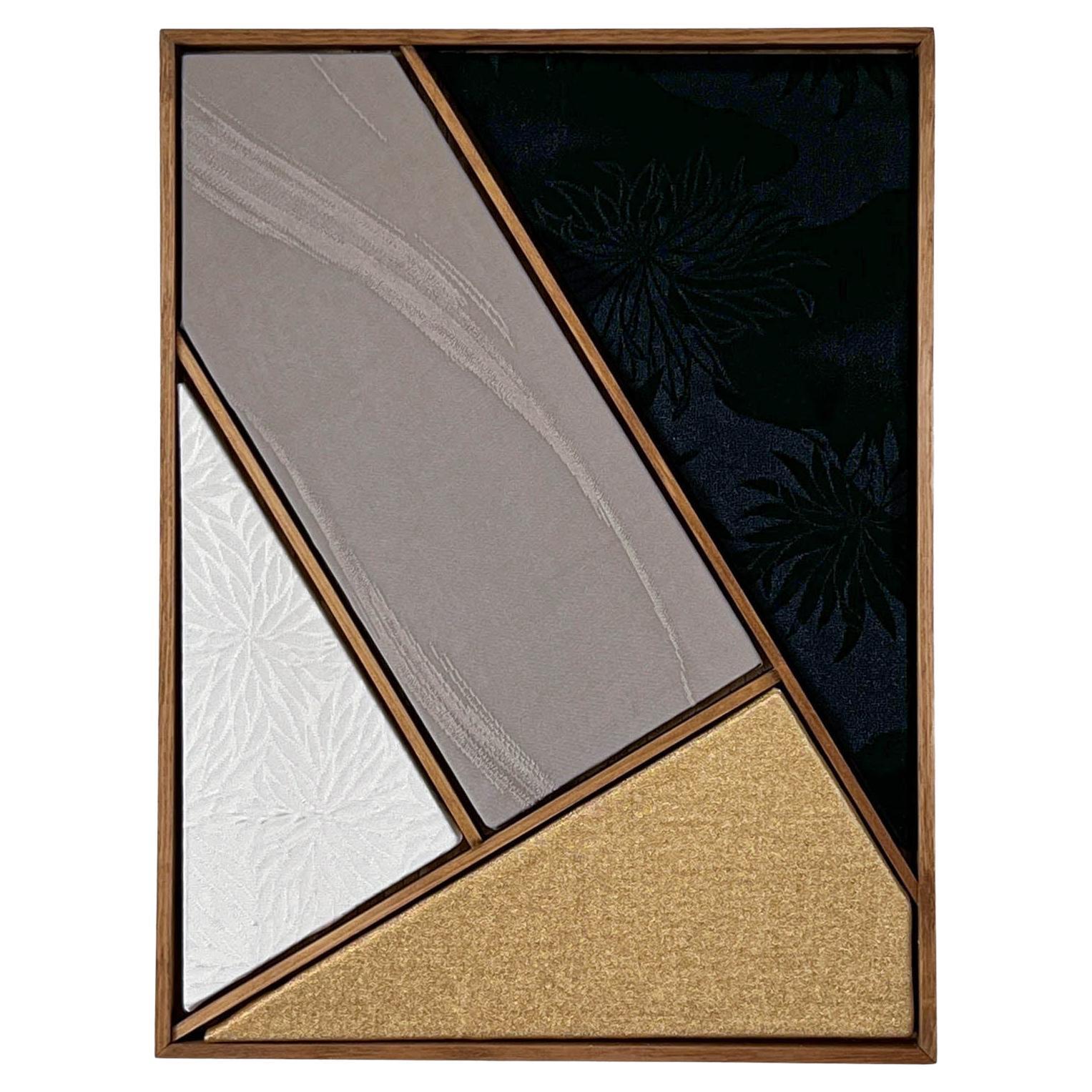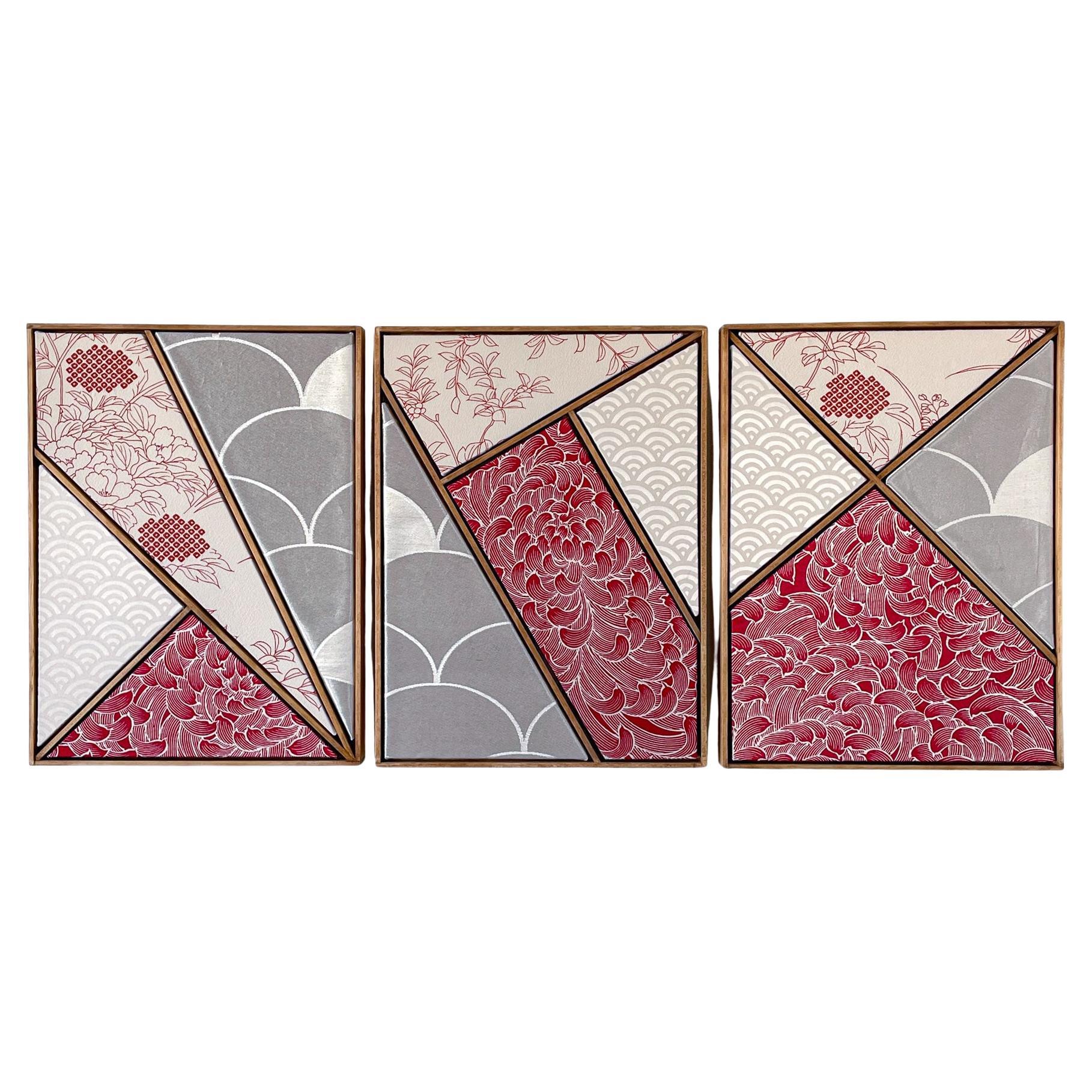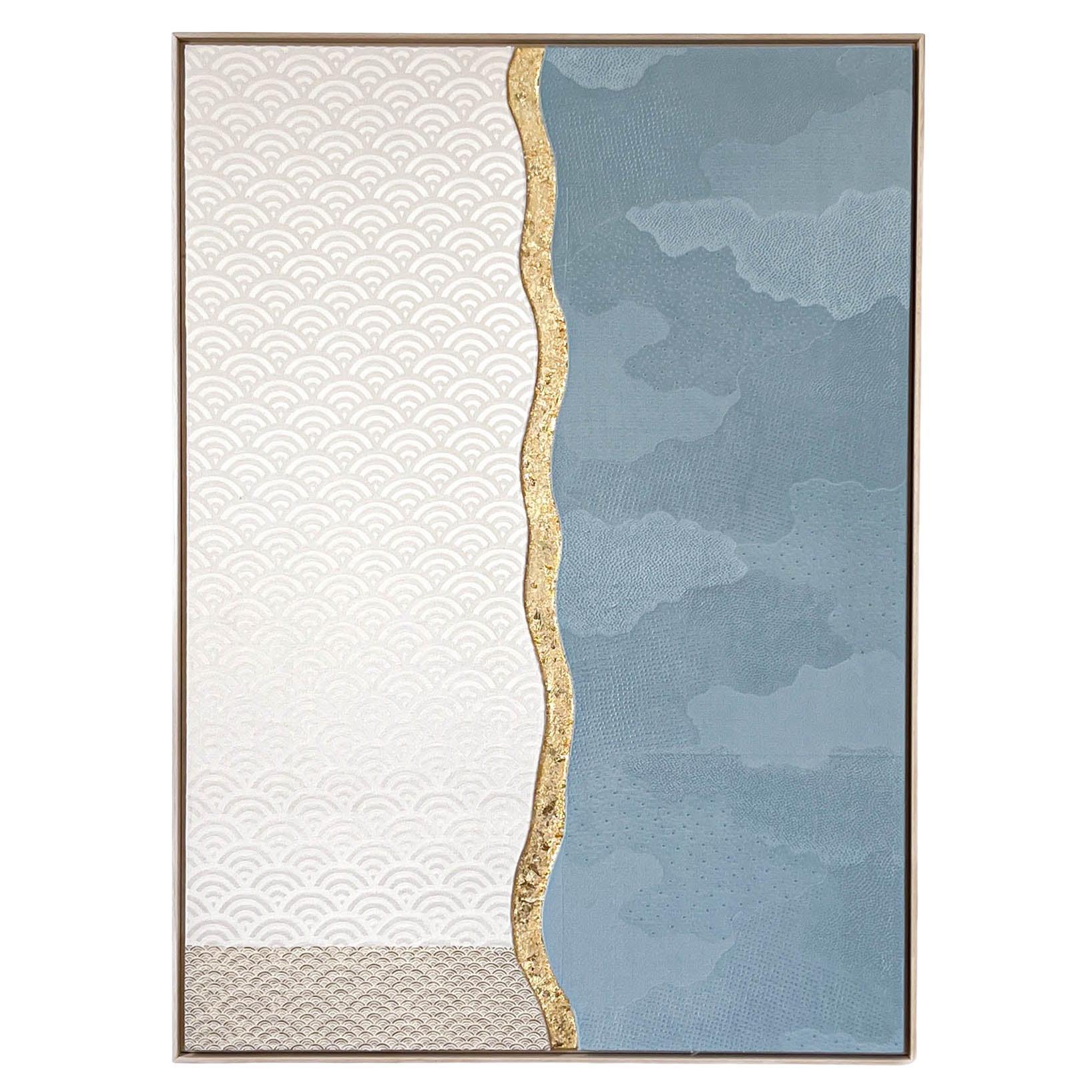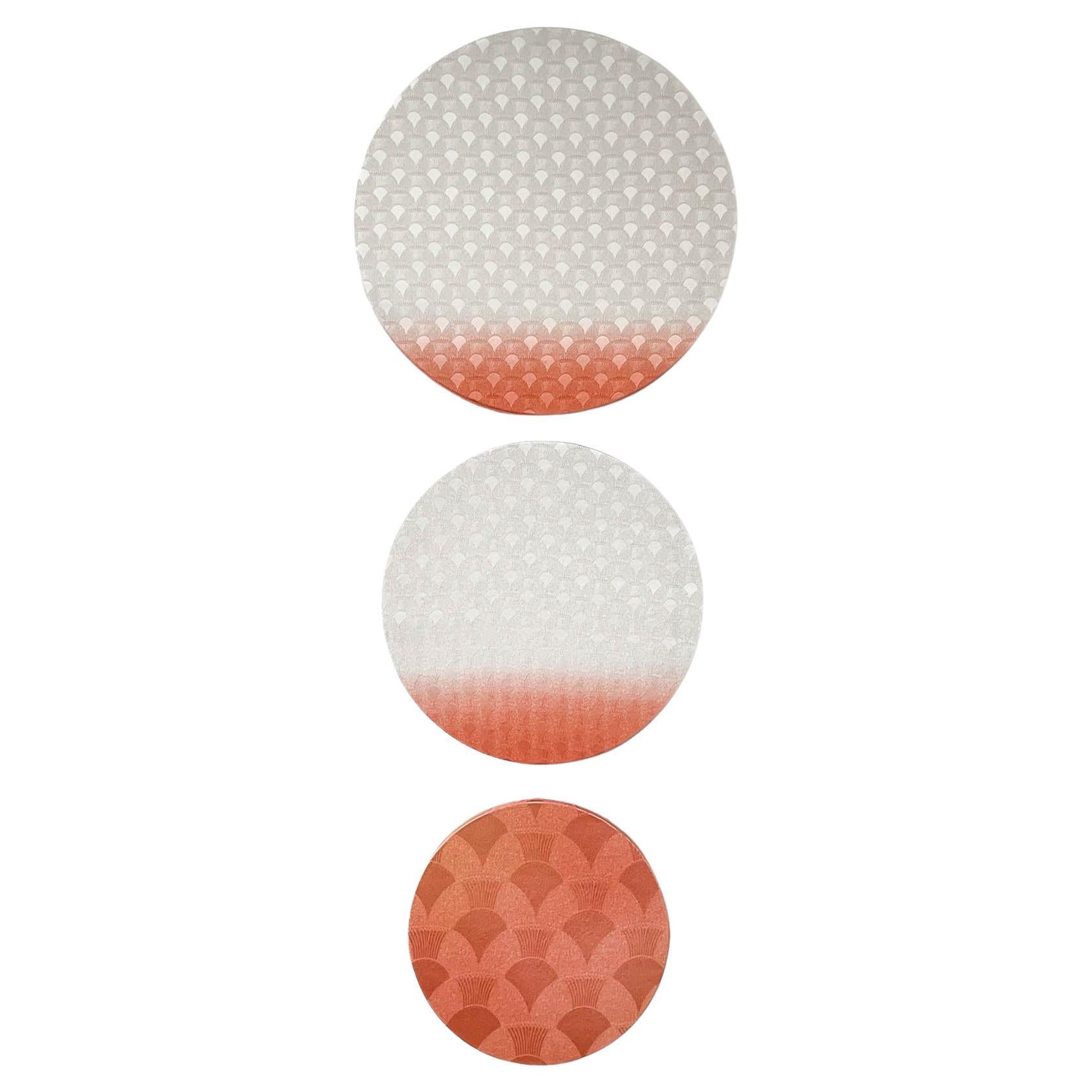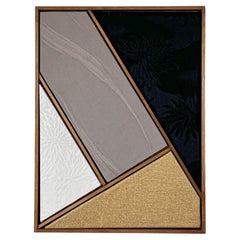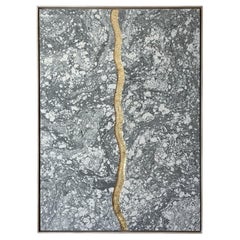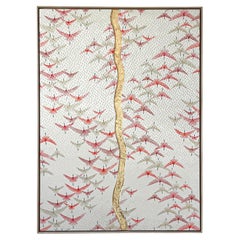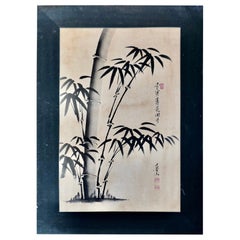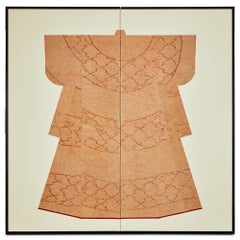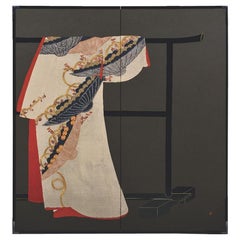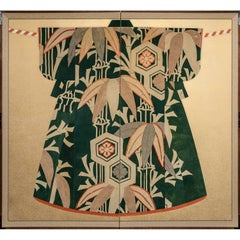Items Similar to VIntage kimono textile art "Geometry ~Marble~" by ikasu Gold, White, Grey, Japan
Want more images or videos?
Request additional images or videos from the seller
1 of 18
VIntage kimono textile art "Geometry ~Marble~" by ikasu Gold, White, Grey, Japan
About the Item
This work is inspired by traditional Japanese nature motifs symbolism, and is framed in paulownia wood originally used for a kimono chest-of-drawers.
It is elegantly framed with paulownia wood originally used for kimono chest-of-drawers, and is filled with storytelling and sense of luxury.
I used pieces of kimono that could no longer be used as clothing and kiritansu chest-of-drawers that would normally be discarded to create the ultimate upcycled piece.
<< Explanation and meaning of pattern and colors >>
The noshi pattern, often seen on kimono, holds significance rooted in Japanese culture and tradition. The term "noshi" originally referred to a ceremonial cord made from dried abalone or dried strips of dried fish, which was used to tie together gifts or offerings. Over time, the noshi pattern evolved into a decorative motif with its own symbolic meanings. Here are some interpretations of the noshi pattern on kimono:
・Celebration and Good Wishes: The noshi pattern is often associated with celebrations and well-wishes. It symbolizes joy, congratulations, and good fortune, making it a popular choice for kimono worn during festive occasions such as weddings, graduations, or New Year's celebrations. The pattern conveys sentiments of happiness and auspiciousness, reflecting the positive intentions of the wearer.
・Symbol of Respect and Appreciation: Historically, noshi were attached to gifts as a symbol of respect and appreciation for the recipient. Similarly, the noshi pattern on kimono can be interpreted as a gesture of respect towards tradition and cultural heritage. It may also symbolize gratitude for life's blessings and the importance of maintaining harmonious relationships with others.
・Wish for Longevity and Prosperity: In some contexts, the noshi pattern is associated with wishes for longevity and prosperity. The intricate folds and layered appearance of the noshi motif may evoke the image of a tied bundle, symbolizing abundance, security, and continuity. By wearing the noshi pattern, individuals may express their hopes for a long, prosperous, and fulfilling life.
・Elegant Aesthetic: Beyond its symbolic meanings, the noshi pattern is valued for its aesthetic appeal and decorative qualities. The geometric arrangement of overlapping rectangles or diamond shapes creates a visually striking design that adds depth and texture to the fabric of the kimono. Whether woven, embroidered, or printed, the noshi pattern enhances the overall beauty and elegance of the garment.
Overall, the noshi pattern on kimono carries multifaceted meanings, encompassing themes of celebration, respect, good fortune, longevity, and aesthetic appreciation. It serves as a cultural emblem that honors tradition while also expressing personal sentiments and aspirations.
<< Characteristics of the fabric >>
Marble pattern fabric and white fabric with noshi pattern is taken from kimono, golden one - from an obi belt.
<< About the frame >>
Kiritansu - chest-of-drawers for kimono, is traditionally made from paulownia wood, a uniquely Japanese material closely tied to the world of kimonos.
Paulownia wood is known as the lightest wood in Japan, prased for its natural luster, resistance to moisture, and resilience against cracking. Since ancient times, it has been used in crafting furniture, chests, and musical instruments.
During the Edo period, it became customary to store cherished kimonos in paulownia chests, which offered fire resistance and protection from moisture and insects.
Traditionally, when a daughter was born, a paulownia tree would be planted. Upon her marriage, the tree would be cut down, and the wood would be used to craft a chest for her as a wedding gift.
Following the Ansei Earthquake during the late Edo period in 1855, paulownia chests gained popularity due to their ability to withstand fires and even float in water, thereby safeguarding their contents during floods.
I use antique kiritansu that can’t be used as furniture anymore to create basis and frames for my works. It adds them even more authentic atmosphere of traditional wabisabi spirit. Can you feel it?
- Creator:Kimono ikasu (Artist)
- Dimensions:Height: 15.75 in (40 cm)Width: 11.82 in (30 cm)Depth: 1.58 in (4 cm)
- Style:Japonisme (In the Style Of)
- Materials and Techniques:
- Place of Origin:
- Period:
- Date of Manufacture:around 1960ies
- Condition:
- Seller Location:Setagaya City, JP
- Reference Number:1stDibs: LU10079243379442
About the Seller
New to 1stDibs
Joined in the past six months.
No Reviews Yet
Vetted Professional Seller
Every seller passes strict standards for authenticity and reliability
1stDibs seller since 2024
- ShippingRetrieving quote...Shipping from: Setagaya City, Japan
- Return Policy
Authenticity Guarantee
In the unlikely event there’s an issue with an item’s authenticity, contact us within 1 year for a full refund. DetailsMoney-Back Guarantee
If your item is not as described, is damaged in transit, or does not arrive, contact us within 7 days for a full refund. Details24-Hour Cancellation
You have a 24-hour grace period in which to reconsider your purchase, with no questions asked.Vetted Professional Sellers
Our world-class sellers must adhere to strict standards for service and quality, maintaining the integrity of our listings.Price-Match Guarantee
If you find that a seller listed the same item for a lower price elsewhere, we’ll match it.Trusted Global Delivery
Our best-in-class carrier network provides specialized shipping options worldwide, including custom delivery.More From This Seller
View AllVIntage kimono textile art " Monochrome Geometry " by ikasu Gold, Grey, Japan
By Kimono ikasu
Located in Setagaya City, JP
This work is inspired by traditional Japanese nature colors symbolism, and is framed in paulownia wood originally used for a kimono chest-of-drawers.
It is filled with storytelling ...
Category
Vintage 1960s Japanese Japonisme Paintings and Screens
Materials
Silk, Wood
VIntage kimono textile art "Geometry ~Chrysanthemums" by ikasu, white, red Japan
By Kimono ikasu
Located in Setagaya City, JP
This work is inspired by traditional Japanese natural symbolism, and is framed in paulownia wood originally used for a kimono chest-of-drawers.
It is elegantly framed with paulownia...
Category
Vintage 1960s Japanese Japonisme Paintings and Screens
Materials
Silk, Wood
Vintage kimono textile art "Marble Story ~ Healing ~" by ikasu Grey, Japan
By Kimono ikasu
Located in Setagaya City, JP
This work uses a vintage kimono fabric with marble pattern, that makes it look like a real piece of marble.
The line in the middle symbolizes “kintsugi” - concept of wabi-sabi, which values imperfection, impermanence, and the beauty of aging.
It is elegantly framed with paulownia wood originally used for kimono chest-of-drawers, and is filled with storytelling and sense of luxury.
I used pieces of kimono that could no longer be used as clothing and kiritansu chest-of-drawers that would normally be discarded to create the ultimate upcycled piece.
<< Explanation and meaning of pattern and colors >>
Kintsugi (金継ぎ), which translates to "golden joinery" or "golden repair," is a traditional Japanese art form of repairing broken pottery with lacquer mixed with powdered gold, silver, or platinum. I used this tecnique here to "repair" antique kimono by transforming it into art work. Beyond its literal meaning of mending broken ceramics, kintsugi carries profound philosophical and cultural significance in Japanese tradition:
・Embracing Imperfection: Kintsugi celebrates imperfection and impermanence. Rather than disguising or concealing flaws, it highlights them, treating the breakage as part of the object's history. This philosophy encourages acceptance of imperfection as an essential aspect of life, beauty, and human experience.
・Wabi-Sabi Aesthetic: Kintsugi embodies the principles of wabi-sabi, an aesthetic worldview centered on the acceptance of transience and imperfection. Wabi-sabi values simplicity, authenticity, and the beauty of things that are imperfect, impermanent, and incomplete. Kintsugi exemplifies these principles by turning what might be considered flaws into features that enhance the object's beauty and character.
・Resilience and Transformation: The act of repairing broken things with precious metals symbolizes resilience and transformation. Instead of discarding or replacing the broken object, kintsugi honors its history and transforms it into something new and valuable. This reflects broader philosophical themes of overcoming adversity, finding beauty in imperfection, and embracing change.
・Honoring the Past: Kintsugi preserves and honors the history of the object. Rather than erasing or ignoring its past, it acknowledges and celebrates it. This aspect of kintsugi can be seen as a metaphor for honoring our own personal histories, including the challenges and setbacks we have faced, and recognizing how they have shaped us into who we are today.
・Spiritual and Philosophical Symbolism: Kintsugi has spiritual and philosophical implications, reflecting concepts such as the interconnectedness of all things, the cycle of life and death, and the pursuit of harmony and balance. The process of repairing broken objects with precious metals is seen as a metaphor for spiritual growth, enlightenment, and the journey towards wholeness.
Overall, kintsugi represents not only a practical technique for repairing ceramics but also a profound philosophical and cultural perspective on life, beauty, and the human experience. It embodies values such as resilience, acceptance, and the transformative power of embracing imperfection.
<< Characteristics of the fabric >>
This vintage textile is hand-painted with a traditional painting technique where the colors are added on wet surface, which creates an effect of marble.
<< About the frame >>
Kiritansu - chest-of-drawers for kimono, is traditionally made from paulownia wood, a uniquely Japanese material closely tied to the world of kimonos.
Paulownia wood is known as the lightest wood in Japan, prased for its natural luster, resistance to moisture, and resilience against cracking. Since ancient times, it has been used in crafting furniture, chests, and musical instruments.
During the Edo period, it became customary to store cherished kimonos in paulownia chests...
Category
Vintage 1960s Japanese Japonisme Paintings and Screens
Materials
Gold Leaf
Vintage kimono textile art " Cranes ~ Kintsugi ~ " by ikasu White/Red/Gold Japan
By Kimono ikasu
Located in Setagaya City, JP
The frame for this work is made of paulownia wood taken from antique Kiritansu - chest-of-drawers for kimono.
I use antique kiritansu that can’t be used as furniture anymore to create basis and frames for my works. It adds them even more authentic atmosphere of traditional wabisabi spirit. Can you feel it?
The piece uses the concept of "kintsugi" - it "unites" the pieces of antique kimono back together with golden leaf to give it a second wind as art work.
<< Period / Story >>
The kimono used in this piece was originally crafted during the late Showa period (1960-80ies).
<< Explanation and meaning of pattern and colors >>
The Japanese saying goes, "A crane lives a thousand years, a tortoise lives ten thousand years," making cranes a symbol of longevity.
Cranes are also known for staying with the same partner for their entire lives, which is why they are often used at weddings and other celebrations to symbolize "marital bliss" and the desire for harmony between husband and wife.
On this particular piece, cranes are flying through snow woven on the fabric, as if they are overcoming all the disasters to get to their beloved ones.
The color scarlet, or deeply dyed red, used for the most of the cranes here, has long been associated with the meaning of "warding off evil." It is believed to possess the power to repel malevolent forces and invite good fortune.
During the Heian period, scarlet was reserved for sacred buildings and ceremonial objects that held great significance. Ordinary people were prohibited from wearing scarlet-red kimonos, which made it a highly special color.
<< Characteristics of the fabric >>
Cranes, going up and down, are generously decorated by kimpaku here. "Kimpaku" (金箔) refers to gold leaf/foil in Japanese. Gold leaf is a traditional material used in various aspects of Japanese culture, including art, crafts, and even in culinary applications.
In traditional Japanese art, gold leaf is often applied to religious objects, sculptures, paintings, and lacquerware to create a luxurious and decorative effect. The use of gold leaf in art dates back centuries and is associated with a sense of wealth, prestige, and the divine.
Traditional kimpaku technique is used here to make an accent decoration in the middle.
<< About the frame >>
This artwork frame is crafted from paulownia wood, a uniquely Japanese material closely tied to the world of kimonos, and it serves to convey the refined beauty of Japanese nature.
Paulownia wood is known as the lightest wood in Japan, prased for its natural luster, resistance to moisture, and resilience against cracking. Since ancient times, it has been used in crafting furniture, chests, and musical instruments.
Paulownia wood is closely linked to kimono culture. During the Edo period, it became customary to store cherished kimonos in paulownia chests...
Category
Late 20th Century Japanese Japonisme Paintings and Screens
Materials
Gold Leaf
Vintage kimono textile art " Seaside ~ Kintsugi ~ " by ikasu White/Blue Japan
By Kimono ikasu
Located in Setagaya City, JP
This work is inspired by the sea and the sky, uses golden leafing as a creative point, framed in paulownia wood originally used for a kimono chest-of-drawers.
In this artwork, the aim was to capture the splendor of Japanese nature, showing the sea, sky, and forests. Traditional Japanese culture, represented by the kimono, and wood, an integral element of Japanese craftsmanship, were used to bring this vision to life.
I used two pieces of kimono that could no longer be used as clothing and bark that would normally be discarded to create the ultimate upcycled piece.
The marriage of Japanese natural materials - silk, paulownia (frame), and pine (branch slices for the center decoration) - and Japanese natural patterns - blue ocean waves and clouds - expresses the magnificent beauty of Japanese nature from various angles.
The central golden leaf decoration stands out as a distinctive feature of this work. The piece uses the concept of "kintsugi" - it "unites" the pieces of antique kimono back together with golden leaf to give it a second wind as art work.
<< Period / Story >>
The kimono used in this piece was originally crafted during the late Showa period (1960-80ies).
<< Explanation and meaning of pattern and colors >>
The kimonos on this canvas have been creatively repurposed into interior artwork. The one on the left represents ocean wave pattern.
Seigaiha waves is regarded as a pattern of good fortune, embodying wishes for eternal happiness and a tranquil life for future generations.
The fabric on the right is embellished with cloud patterns woven in various techniques. Clouds, with their ever-shifting shapes and colors, have long intrigued people as signs of big events or omens.
<< Characteristics of the fabric >>
The kimono used for a part on the left has a lustrous, ivory-colored ground that serves as a backdrop for the vibrant ocean wave pattern expressed through the ground pattern.
On the right fabric, the cloud pattern is beautifully rendered by dyeing both the plain fabric and delicate patterns. This is achieved through the so-called "Yose-komon" technique, where each cloud is adorned with small patterns such as hail, sharks skin pattern, and other intricate details.
Edo komon, created using a refined and advanced dyeing technique that appears as a solid color from a distance, originated during the Edo period (1603-1868) and remains highly popular as formal kimono attire to this day.
<< About the frame >>
Kiritansu - chest-of-drawers for kimono, is traditionally made from paulownia wood, a uniquely Japanese material closely tied to the world of kimonos.
Paulownia wood is known as the lightest wood in Japan, prased for its natural luster, resistance to moisture, and resilience against cracking. Since ancient times, it has been used in crafting furniture, chests, and musical instruments.
During the Edo period, it became customary to store cherished kimonos in paulownia chests...
Category
Late 20th Century Japanese Japonisme Paintings and Screens
Materials
Gold Leaf
Vintage kimono textile art " Plum Gradation " by ikasu Pink, White, Japan
By Kimono ikasu
Located in Setagaya City, JP
This canvas featuring a plum color gradient kimono showcases a unique decorative variation of the popular seigaiha (青海波) sea waves pattern.
The artwork got a Mr. & Mrs. Abe Arts & Cu...
Category
Vintage 1980s Japanese Japonisme Paintings and Screens
Materials
Canvas, Silk
You May Also Like
Vintage Bamboo Japanese Art, Wall Art 5 excellent pieces
Located in Chillerton, Isle of Wight
Vintage Bamboo Japanese Art, Wall Art
5 excellent pieces, on cartridge paper set on Black Silk
Wonderful Vintage pieces, from 1980, 21.5” high, 15.5” wide
ZX281
Category
Vintage 1980s Japonisme Paintings and Screens
Materials
Paper
Japanese Two Panel Screen: Kimono
Located in Hudson, NY
Beautiful 19th century shibori (pin dyed) fabric in kimono form mounted on a simple ground of mulberry paper. Black lacquer trim with beautifully designed bronze mounts. The fabric ...
Category
Early 20th Century Paintings and Screens
Materials
Fabric, Wood, Lacquer, Paper
Japanese Contemporary Red Black Cream Folding Screen Silk Brocade Kimono Art, 3
Located in Takarazuka, JP
Exceptional Japanese contemporary two panel "byobu" or folding screen featuring genryoku style handcrafted silk raised kimono Japanese decorative art in crimson red, black and gold o...
Category
21st Century and Contemporary Japanese Meiji Paintings and Screens
Materials
Gold
Japanese Two Panel Screen: Antique Kimono Fabric Mounted on Screen
Located in Hudson, NY
Japanese Two Panel Screen: Late Nineteenth Century Kimono Fabric Mounted on Early Twentieth Century Screen. In the Heian period (eighth century to the twelfth century), noblemen wou...
Category
Early 20th Century Japanese Meiji Paintings and Screens
Materials
Silk, Wood, Paper
Japanese Two Panel Screen Geometric Design on Mounted Textile
Located in Hudson, NY
In strong primary colors. Makers seal reads: Yu.
Category
Mid-20th Century Japanese Paintings and Screens
Materials
Paint
Japanese Art Deco 4-Panel Screen with Falcon, Ca. 1920
Located in New York, NY
Japanese Art Deco 4-Panel Screen with Falcon, Ca. 1920
DIMENSIONS
Height: 36.25 inches
Width: 71.25 inches
Category
Vintage 1920s Japanese Japonisme Paintings and Screens
Materials
Wood
Recently Viewed
View AllMore Ways To Browse
Japanese Kimono
Japanese Used Kimono
Japanese Marble
Screen Clothing
Vintage Fabric Screen
Vintage White Belt
Woven Belt
Vintage Japanese Hand Painted
Vintage Textile Clothing
Vintage Kimonos
Insect Motif
Chest With Fish
Gold Kimono
Tree Of Life Fabric
Fire Screen Vintage
Vintage Fire Screen Screens
White Kimono
Fold Chest
